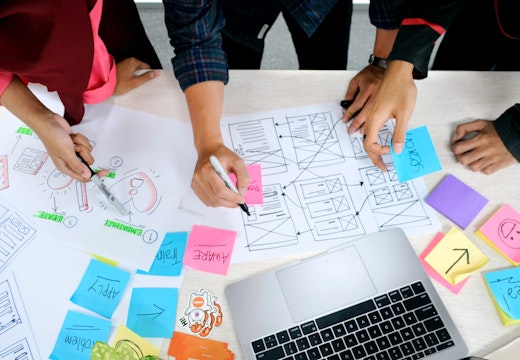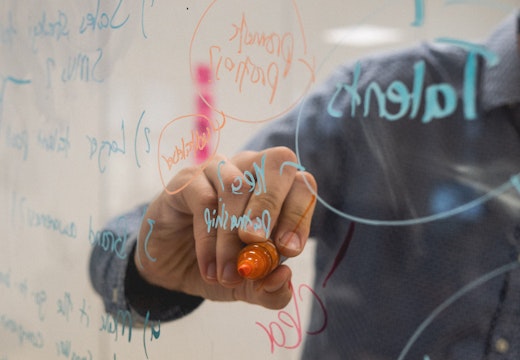How can technology and design collaborate on hybrid?
Technology integrators and interior designers need to work closely to create the hybrid workplace, but too often there is a divide. Canada’s ET Group is using the principles of design thinking to build bridges - is this a blueprint for collaboration?
As organisations look to remodel the workplace for the new demands of hybrid working, technology consultants and design professionals are increasingly required to march to a single drum so that space and technology can be combined to optimum effect to enhance the employee experience.
But bringing together the contributions of technology integrators and interior designers on workplace projects in an effective way is not always easy to achieve. Wires can get crossed, objectives can become obscured and parallel programmes can get out of alignment. Technology and design might have different start points, different working processes and even different feedback loops from the client company grappling with how to make hybrid happen.
So what can be done to build a better collaborative relationship?
Pooling expertise
One way to create a common platform for technology and design to share ideas and pool expertise on projects is through the application of design thinking (DT) principles. Design thinking first emerged in the aftermath of the global financial crash of 2008 as an alternative way to address business problems. It is a creative form of people-centred innovation with a particular focus on involving end users more democratically in the development process.
‘Design thinking creates a better experience for the client by considering the needs of both the space and technology’ – Chris Wheedon, ET Group
Canadian collaboration technology integrator ET Group has been practising DT in collaboration with a range of international clients over the past two years. Its pioneering approach, which was discussed in the first article in this series, has not only enabled ET Group to create more people-centred solutions for hybrid working but has also enabled it to work more effectively with workspace designers.
Chris Wheeldon, who leads design thinking engagements at ET Group, explains: ‘Design thinking is a way to create a better experience for the client by considering the needs of both the space and technology in a collaborative fashion as early as possible.’
Projects can unravel
The scope for misadventure in bringing together the different inputs of technology and design inside the workplace is well-documented. Part of the problem stems from the C-suite historically having a stronger grasp of workplace design than technology. This means that design consultants tend to get hired and properly briefed on new workplace projects while IT decisions remain in-house.
By the time the in-house IT team asks for external integration help on a complex project, things are already starting to unravel. This is because the different consultants have different start points. And while network and infrastructure might be well understood in-house, the human factors of the technology experience far less so. ET Group CEO Dirk Propfe advocates for a more human-centric perspective: ‘When the technology integrator can’t get close to users, you can’t understand the challenges people are facing.’ He adds of the client briefing process: ‘Sometimes we get the documentation, but not the explanation.’
‘When you can’t get close to users, you can’t understand the challenges people are facing…’ – Dirk Propfe, ET Group
There are, however, growing grounds for optimism. Lisa Perrine, a strategic partner and advisor to ET Group on design thinking, sees a clear opening to improve collaboration: ‘Senior people are now more aware of the technology experience because of hybrid work. This creates an opportunity for us.’
The design thinkers at ET Group have been quick to grasp this opportunity, using DT methods and values such as empathy, exploration, co-creation and fail-fast prototyping to build bridges between technology and design. Lisa Perrine adds that use of cloud-based Revit technology creates a shared technical platform, enabling accurate 3D walkthroughs of work interiors so that, for example, hanging light pendants are not installed right in front of LED screens thus obscuring the view of users.
So what are the principles that will enable a better fit between technology and design in creating the hybrid workplace? ET Group believes there are five big things to think about.
Define what success looks like
There needs to be a shared vision of the key success factors on the project at the outset. What is the project trying to achieve? And how can the results be measured against the success factors? Everyone needs to buy into this vision, so ET Group puts a lot of effort into joint team-building activities at the outset so that people can talk about their ideas and their passions – including sharing two-minute success stories – right from the start. CEO Dirk Propfe explains: ‘The relationship between people sets the stage for the process later on.’
Agree on the process
It might sounds obvious, but there needs to be a common understanding of how technology integrators and designers will work together. What are the rules for collaboration? Who needs to be involved? Who owns what decisions? Who leads which part of the project? This practical dimension is often missing according to ET Group’s Lisa Perrine, who adds: ‘Most designers and architects learn the design thinking process in school. It’s sometime about reminding them of what they already know and helping them find a path to return to it.’
Focus on experience, not just appearance
Architects and designers tend to think visually, and not give equal consideration to the acoustics of the work environment. But a large part of the experience of communication technology is about improving sound quality and sightlines. It is therefore important that joint problem-solving between technology and design is more than just about surface appearance and aesthetics. Design thinking enables a process of investigation of user needs that is more than skin deep. Its orientation is towards spending more time at the front end of the innovation process – slowing down the project to concentrate on discovery and definition of user needs – so that the project team can move faster in the later stages.
Prototype together early and often
Joint prototyping of potential solutions to test with users is a key part of the approach – and one of the core values of design thinking. The process can be iterative and messy, concedes Chris Wheedon, but you learn a great deal from these experiments. As companies bring people back to the office, the pace is quickening as clients want to discover what will work in the new hybrid scenario. ‘If it’s a prototype, don’t expect to get it 100 per cent right first time,’ says Lisa Perrine. ‘Try one thing and see how people respond and go from there. Don’t fast track entire solutions before we know it’s the right solution.’
Keep it simple
The final principle is about simplicity. ‘Things can be more complicated than they need to be,’ says Chris Wheeldon, who makes a plea not to over-complicate the work environment with technical or design features that people don’t really need. Design thinking provides the guide rails that enable the whole consulting team to focus on the essentials.
When DT principles become the ‘glue’ that binds together the various inputs of technology integrators and workspace designers, the results can be surprisingly effective. ET Group, for example, recently helped a large Canadian chemical company with a series of manufacturing plants to build out its new offices.
‘We need to jump into each other’s swim lanes to learn together’ – Dirk Propfe, ET Group
Through close analysis of user needs, the team discovered that communicating with the various plants using audio technology in conference rooms was insufficient to get key messages across. Senior people were being forced to fly out to the technical plants to hold the attention of plant supervisors. ET Group worked with the company’s designers to reimagine the office space with video-enabled huddle spaces to improve communication and cut down on endless trips.
ET Group CEO Dirk Propfe concludes: ‘Nothing we do is a black box – we’re inclusive. We need to jump into each other’s swim lanes to learn together. Design thinking works better than pretending you know better than the people who use the space.’








